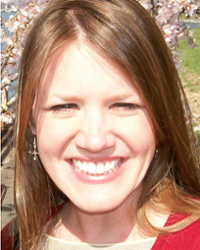“A Cosmic Struggle?: How Historians Grapple with Religion as a Casual Force.”
 Dr. Sarah Cramsey, Assistant Professor in Judaism and Diaspora Studies at Leiden University, visited the College of William & Mary and delivered a lecture entitled “A Cosmic Struggle?: How Historians Grapple with Religion as a Casual Force.”
Dr. Sarah Cramsey, Assistant Professor in Judaism and Diaspora Studies at Leiden University, visited the College of William & Mary and delivered a lecture entitled “A Cosmic Struggle?: How Historians Grapple with Religion as a Casual Force.”
An alum of the College, Dr. Cramsey holds masters degrees from Oxford University and University of California, Berkeley, as well as a doctoral degree from UC Berkeley. Dr. Cramsey has held additional positions at National War College, Tulane University, and Université libre de Bruxelles.
Dr. Cramsey began by highlighting the multivariate approach essential to her study of modern central and eastern European Jewish history. Places like Poland, for example, represent regions marked by Nazi fascism, colonialism, socialism, communism, revolution, and other political forces. Understanding this region, she asserted, hinges on understanding community, otherness, and religion as “hovering”: as ideological forces with the potency to compel thoughts and actions. For a scholar to study the Jewish experience in this region requires the scholar to step into a “deeper awareness of lived and imagined religion.”
One case requiring this deeper awareness was Dr. Cramsey’s approach to studying the internal relations of Jewish communities in these regions. For example, a holistic examination of older Jewish communities requires scholars to circumvent strictly hagiographical retellings of rabbinic leadership and its curation of homogenous Jewish life. Dr. Cramsey resorted to undertaking the study of historical Jewish families: a study leading her to find that family accounts of historical Jewish communities often demysticized narratives of rabbinic history. For example, hagiographical literature characterizes the Ba’al Shem Tov as a hermetic figure who embodied complete separation from the rest of European society. Accounts of families in his community, however, render this narrative not just unrealistic but untrue. They characterize the Ba’al Shem Tov as a doctor, neighbor, and citizen of his country. Family accounts also challenge narratives of isolation from Christian society, showing that many Jews had Christian neighbors as babysitters, teachers, and housemaids. This led Dr. Cramsey to examine what she considers a universally experienced but universally forgotten phenomenon: infancy. “How does one capture early childhood?” she pried, characterizing it as an “experience of being taken care of that everyone shares but no one remembers.” Cultivation of Jewish identity and religion must be an integral part of the child-rearing process, Dr. Cramsey asserted. Far before formal religious education begins, the processes associated with breastfeeding, language training, and other psycho-physiological developments show that religious identity contains a fundamentally biological component.
Dr. Cramsey has developed this approach to further examine how Jewish identity has been transmitted to children over the centuries and into the modern era. And, Dr. Cramsey argues, this methodology maps out not just the processes of Jewish identity, but anti-Jewish identity as well. If, at minimum, a vague sense of religious identity – the “hovering” ideology capable of compelling thought and action – can be inculcated into those infancy, can this understanding of ideology contribute to a rational explanation of the “soft antisemitism” that wormed its way into much of Polish culture as well, and eventually resulted in mass murder? Much of the origins of antisemitism - more appropriately described by “anti-Judaism”- find historical context beginning with New Testament literature, subsequent theology, and eventual “blood libel” conspiracies resulting in frequent pogroms in the premodern and modern eras. But a kind of “soft antisemitism” undergirded each of these actions: perhaps a household joke, a dinnertime conversation, or a sermon on Matthew 27. Soft antisemitism, of the kind beginning at birth and permeating the household, Dr. Cramsey concludes, turns violent under pressure. This is the basis much of her understanding of why parameters of morality changed after Nazi invasion. A sense of legitimacy or normalcy materialized intuitions into action. Indeed, even throughout the course of the war, Dr. Cramsey found, Christians in Polish towns grew evermore willing to assist in loading Jews into cattle cars, robbing houses, and scouring the countryside for those in hiding. Nazi ideology’s blurring of ethnic and religious lines caused a compound effect as well, further weaponizing soft antisemitism into violence and cruelty. Sustained violence occurred after the war, Dr. Cramsey noted, including deliberate Polish Christian attacks on Holocaust survivors in 1946 and at least three other major pogroms stemming from resurrected blood libel accusations. The damage of Nazi occupation–both physical and ideological occupation–left the moral parameters of daily Christian life in ruins long after the Nazis surrendered.
Dr. Cramsey concluded by remarking on the rather grim nature of uncovering this sentiment and the human susceptibility to external pressure. She drew close attention to the fact that from more than 50 countries, Yad Vashem has honored over 27,000 “righteous gentiles” who risked their lives to help their Jewish neighbor and that 7,177 of these honorees were Polish Christians, far more represented than any other demographic. Many of these heroes did so for explicitly religious reasons, thus rendering a purely negative interpretation of Polish Christianity in the 1940s incomplete and incorrect. Rather, Dr. Cramsey, argued, these examples further demonstrate the importance of understanding the capability of religious ideology to motivate action–whether for good or evil–under the pressure of turbulent times. As the lecture closed, Dr. Cramsey noted the personal importance of joining the larger conversation of history and celebrated searching for the “frustrating but illuminating reality” of the Polish past.














